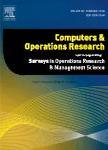版权所有:内蒙古大学图书馆 技术提供:维普资讯• 智图
内蒙古自治区呼和浩特市赛罕区大学西街235号 邮编: 010021

作者机构:Univ Fed Sao Carlos Dept Prod Engn Via Washington Luiz Km 235 BR-13565905 Sao Carlos SP Brazil
出 版 物:《COMPUTERS & OPERATIONS RESEARCH》 (计算机与运筹学研究)
年 卷 期:2020年第115卷
页 面:104851-000页
核心收录:
学科分类:1201[管理学-管理科学与工程(可授管理学、工学学位)] 08[工学] 0812[工学-计算机科学与技术(可授工学、理学学位)]
基 金:Sao Paulo Research Foundation (FAPESP) [16/08039-1, 16/01860-1, 13/07375-0] National Council for Scientific and Technological Development (CNPq-Brazil) [200745/2018-2] Coordenacao de Aperfeicoamento de Pessoal de Nivel Superior -Brasil (CAPES) FAPESP Fundacao de Amparo a Pesquisa do Estado de Sao Paulo (FAPESP) [16/08039-1] Funding Source: FAPESP
主 题:Cutting & packing problems Constrained two-dimensional cutting Non-staged and staged guillotine cuts Mixed integer linear programming Bottom-up packing
摘 要:In this paper, we address the Constrained Two-dimensional Guillotine Placement Problem (C2GPP). This problem considers a rectangular large object and a set of rectangular small item types of given sizes and values. The objective is to select and cut the most valuable subset of small items from the large object using orthogonal guillotine cuts and constrained patterns. To completely model the problem, we present pseudo-polynomial and compact integer non-linear formulations. Then, we obtain an equivalent Mixed Integer Linear Programming (MILP) formulation from each non-linear model. These novel formulations are related to a bottom-up packing approach of successive horizontal and vertical builds of the small items. Additionally, we develop a set of constraints for each model which allows us to strictly consider d-staged guillotine cutting patterns, for a given positive integer d. To evaluate the MILP models and compare their performance to the state-of-the-art formulation of the C2GPP, we run computational experiments using three sets of benchmark instances, two of them from the literature. The results show that the proposed models, based on a bottom-up packing approach, lead to optimal or near-optimal solutions in reasonable processing times, even for scenarios that are intractable for the benchmark model. (C) 2019 Elsevier Ltd. All rights reserved.